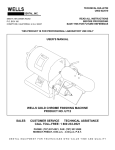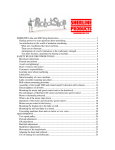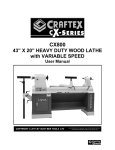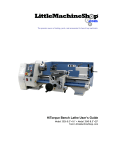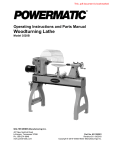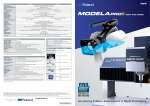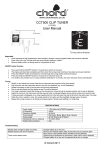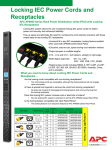Download Instructions - Draper Tools
Transcript
- Blank page - 9A - Blank page - 9B 6. TECHNICAL DESCRIPTION 6.1 IDENTIFICATION Cable and non re-wireable plug. Door latch. ON/OFF switch. Variable speed dial. Hand wheel. Digital display. Headstock. Drive spur. Tool rest. 10B Tool rest locking bolt. Tool rest base. Drive spur. Tailstock. Tail spur adjustment knob. Locking handle. Motor plate. 7. UNPACKING & CHECKING 7.1 PACKAGING Carefully remove the product from the packaging and examine it for any sign of damage that may have happened during shipping. Lay the contents out and check them against the parts shown below. If any part is damaged or missing; please contact the Draper Helpline (the telephone number appears on the Title page) and do not attempt to use the product. The packaging material should be retained at least during the guarantee period: in case the machine needs to be returned for repair. Warning! Some of the packaging materials used may be harmful to children. Do not leave any of these materials in the reach of children. If any of the packaging is to be thrown away, make sure they are disposed of correctly; according to local regulations. 7.2 WHAT´S IN THE BOX? As well as the lathe; there are several parts not fitted or attached to it. Hex. keys. Push rod. Spanner. Face plate. 10A 10. BASIC WOOD TURNING 10.9 USING A SKEW CHISEL - FIGS. 29 - 32 Two skew chisels 12, 25mm are all that are required for general use although other sizes are available (refer to Draper Catalogue). This chisel is used mostly for making finished cuts, to cut vees and beads and square shoulders. When correctly used, it will produce the best finish that can be obtained with a chisel. It should not be used for scraping as this will quickly dull it. For finish cutting, the skew should be held with the cutting edge considerably in advance of the handle and should be bevel against the work. Good practice is to place the skew well over the workpiece and pull it back until the edge begins to cut; then swing the handle into position to advance the cut. Both the toe and the heel of the skew can be used for making light cuts; but do not penetrate the wood too deeply without cutting clearances as you may burn the tip of the tool. Refer to Figs.29, 30, 31, 32 & 33. FIG.29 Swing tool Pull back FIG.30 Path of cut Direction of cut FIG.31 Using toe FIG.32 No support FIG.33 Edge does not cut Using heel 19 10. BASIC WOOD TURNING 10.10 USING A PARTING CHISEL - FIGS. 34 - 35 FIG.34 A parting chisel has one primary purpose - to cut straight into the workpiece as deep as desired, or all the way through the workpiece to make a cut off. This is a very narrow chisel, approximately 3mm wide and is shaped to cut its own clearance, so the cutting edge will not burn. But when used as a scraper, it should be backed off at regular intervals to prevent overheating. See Fig.34, 35. FIG.35 10.11 USING SCRAPING CHISELS - FIGS. 36 - 38 Finally, three more types of chisel should complete the list of chisels for the average craftsman, these are 12mm spear point, 12mm round nose and 26mm flat nose. Each of these chisels may be purchased in various sizes, (refer to the Draper Catalogue) for special jobs. All of these are very useful for diameter scraping (see Figs.36, 37, 38) operations and for circumference scraping when cutting methods cannot be employed. The spear point chisel is used for fine scraping and delicate operations such as the forming of beads, parallel grooves and shallow vees. Edges and bowl contours can be rounded with the round nose chisel. Any flat surface can be scraped with the flat nose chisel. FIG.37 20 FIG.36 FIG.38






























